



Late April through late September
Atlanta, GA, is 30 minutes away
5 months
Amounting to a whopping 2,190 miles, the Appalachian Trail leads determined hikers through the immaculate wilderness of Eastern U.S. But out of 3,000 aspiring thru-hikers, only 1 in 4 makes it through. Having a support system, though, changes things. A lot. Your backpack is significantly lighter, you never worry about resupplies, and you don’t waste any time or money hitching rides into town. All of that is possible with a trusted team and a motorhome meeting you every 1-3 days. By doing longer mile days, you get to reach the iconic Mt. Katahdin faster! But there’s no rush. The journey itself is the destination. You’ll pass through a myriad of national parks, forests, and wildlife refuges. You’ll scramble across van-sized boulders, climb steep ridges boasting stellar views, or trudge below impenetrable foliage. And almost every night, you’ll pitch your tent under the stars. This is your sign to finally act on that thought that’s been at the back of your mind for a while.
Traverse 2,190 miles across 14 states, 6 national parks, 8 national forests, and 2 wildlife refuges
By doing a supported thru-hike of the AT, your chances of finishing it increase significantly
Become a part of the eclectic thru-hiking community, adopt a trail nickname, and make lifelong friends


The Appalachian Trail needs no introduction. Thru-hiking its 2,190 miles is on top of many bucket lists, but actually embarking on this 5-7 month journey is something only the bravest do—and only a portion of thru-hikers finish it. With a supported thru-hike of the AT, your chances of succeeding significantly increase. You’ll have your support vehicle—a motorhome where you store all your extra food, gear, clothing, and toiletries—meeting you every 1-3 days, and this will also serve as a security check. Once a week, you’ll be transferred into town for a hostel, hotel, or cabin stay, where you can resupply, shower, and do laundry. Embark on an epic journey and finish one of the most famed long-distance trails in the world.
The hike will start in late-April or early May. This is a rough estimate of what a 5-month thru-hike of the Appalachian Trail northbound will look like. Each hiker can hike at their own pace. If you’re interested about what you can expect from hiking in each of the 14 states the AT passes through, we encourage you to look it up—there are numerous guidebooks written about the trail and the internet is also a great source of information. Learn how to prepare for thru-hiking the Appalachian Trail and check out these 15 AT hiking tips for first-timers by a three-time AT thru hiker.
To learn more about what you can expect regarding the logistics of AT’s supported hike, scroll down and check out the FAQ.
Prior to actually getting on the trail and starting your epic journey, you’ll have a 3-day orientation in Villa Rica, GA to prepare. You’ll go over gear, clothing, food, and the itinerary with your guides and your fellow thru-hikers. Shuttle to Amicalola Falls State Park, where you will register for the thru-hike. Then you’ll get transferred to Springer Mountain, the southern terminus where your life-changing adventure begins.
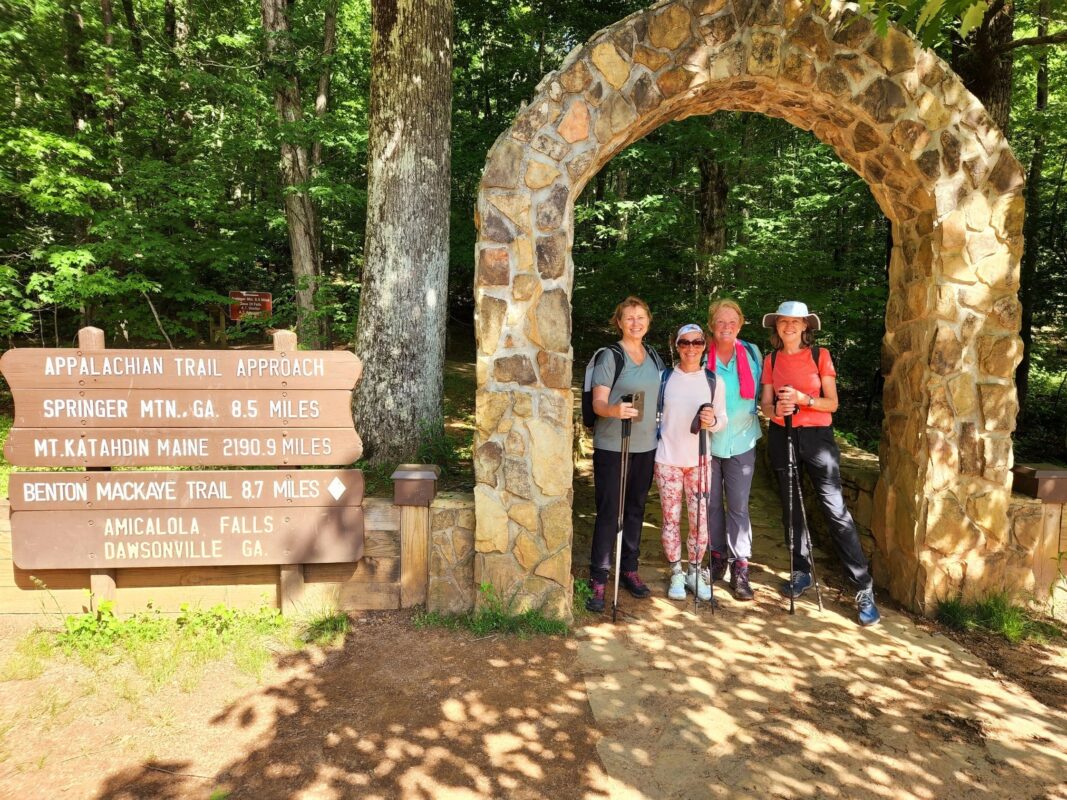
You’ll spend your first month passing through Georgia and North Carolina.
Georgia is a fantastic place to get into the mindset of thru-hiking—the trail is wide and smooth and the terrain is relatively easy compared to the rest of the trail. You’ll begin your journey in Springer Mountain and soon you’ll get used to life in the wilderness.
Distance: 78.1 miles (125.7 km)
North Carolina starts to give you an idea of (literal) ups and downs of the AT. Just south of the Smokies, you can expect long climbs and many scenic views. The NC portion of the trail continues along the border with Tennessee.
Distance: 96.4 miles (155.1 km)
Keep in mind that the weather will be very cold with possible snow and ice at times. Average day temperatures could be anywhere between 20 and 50° F, while at night it could go down to 0° F.

Hike through your first trail town on the AT! These communities recognized as valuable places for thru-hikers, providing food, supplies, history, recreation, and much more. Once you’ve passed through the Smokies, the weather usually starts to warm up, and it could be time for a gear change.
Border of North Carolina & Tennessee runs along Great Smoky Mountains NP ($25 permit required), the most biologically diverse and the most visited national park in the States. Spectacular vistas are guaranteed, as you’ll frequently climb above 5,000 and 6,000 ft (1,524-1,829 m) and pass through the highest point of the AT, the 6,625-foot (2,019-m) Clingmans Dome. You’ll reach your first trail town, Hot Springs.
Distance: 217.8 miles (350.5 km)
Tennessee welcomes you with the 2nd trail town of the AT, Erwin. Other than that, highlights of the state might be high-elevation summits, dense forests, and Laurel Fork, a serene gorge featuring 40-foot waterfalls. Hopefully, you’ll hit your 3rd trail city, Damascus, Virginia, just in time for a hiker festival, where you can expect a parade,arts & crafts booths, gear booths, prize giveaways, food trucks, and more!
Distance: 74.7 miles (120.2 km)
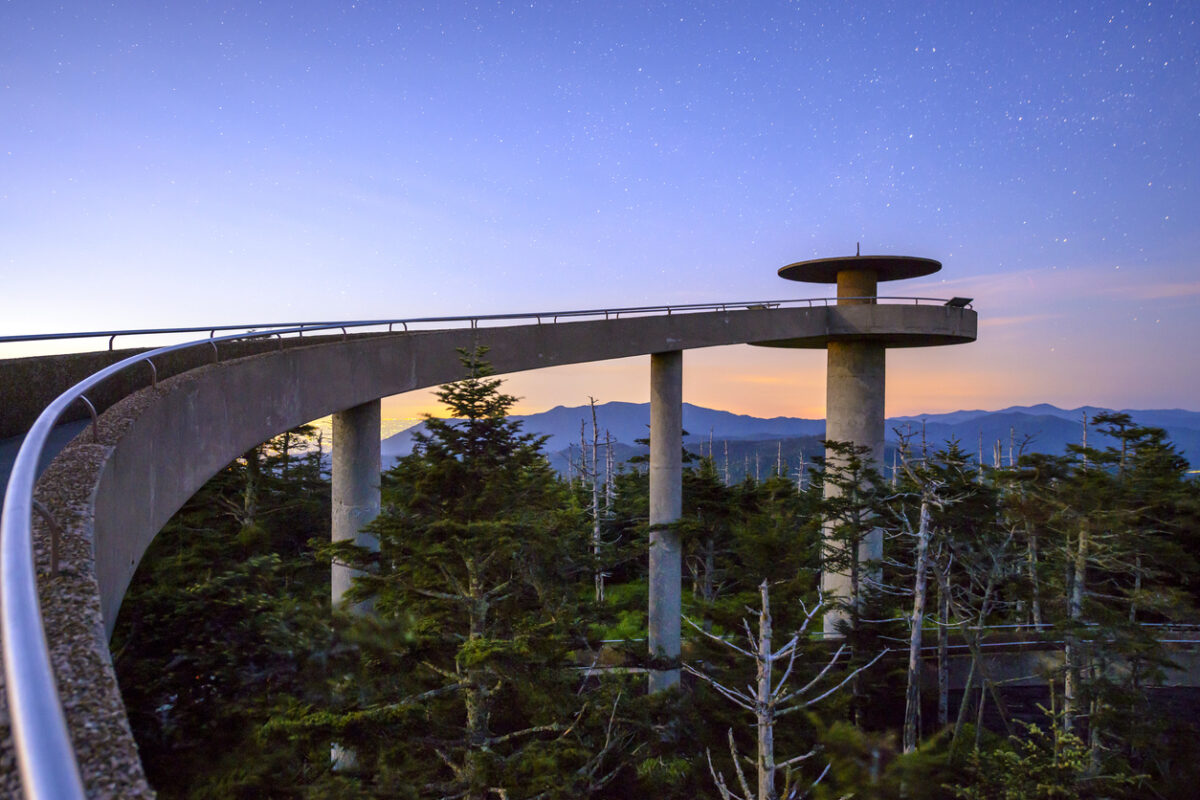
Weather begins to warm up so you’ll need to switch to summer gear, which means a lighter backpack! Average day temperatures are around 50 to 90°F during the day, while the night brings a bit cooler weather at around 40 to 60°F.
Virginia has more miles of the AT than any other state, accumulating nearly a quarter of the entire trail length, and it’s a place where you’ll spend at least a month. While Southern Virginia is a challenging section featuring long climbs along the Blue Ridge Parkway, Northern Virginia and Shenandoah National Park boast mellow sections on farmland and rolling hills. Exit the park around Front Royal, and you’ll soon enter West Virginia.
Distance: 541.7 miles (871.8 km) + 25.2 miles (40.6 km) along VA/WV border

In July, the weather starts getting hot and humid. Be prepared for day temperatures going above 85° F. The terrain starts to get easier and flatter, but the trail itself becomes rockier.
West Virginia’s section of the Appalachian trail is by far the shortest, but still very important for thru-hikers as they pass through Harpers Ferry. Apart from being a site of notable Civil War battles, it’s also home to Appalachian Trail Conservancy’s headquarters and a symbolic AT midpoint.
Distance: 2.4 miles (3.9 km)
Maryland is a fan favorite—it hosts some of AT’s gentlest and flattest terrain, you can hike it in just 2 days, and it’s close to the buzzing Washington, D.C. Consider Maryland the calm before the storm, as you have the rocky Pennsylvania next up.
Distance: 40.9 miles (65.8 km)
Pennsylvania, also known as “Rocksylvania”, is where you get to show what you’re made of. While the north features rocky terrain that’ll test your feet, southern PA offers some of the smoothest terrain of the whole AT. Factor in historic landmarks and charming towns along the way as well as expansive views off the top of ridges, and you’ll find that you have to gird your loins for Pennsylvania’s rewards.
Distance: 229.8 miles (369.8 km)
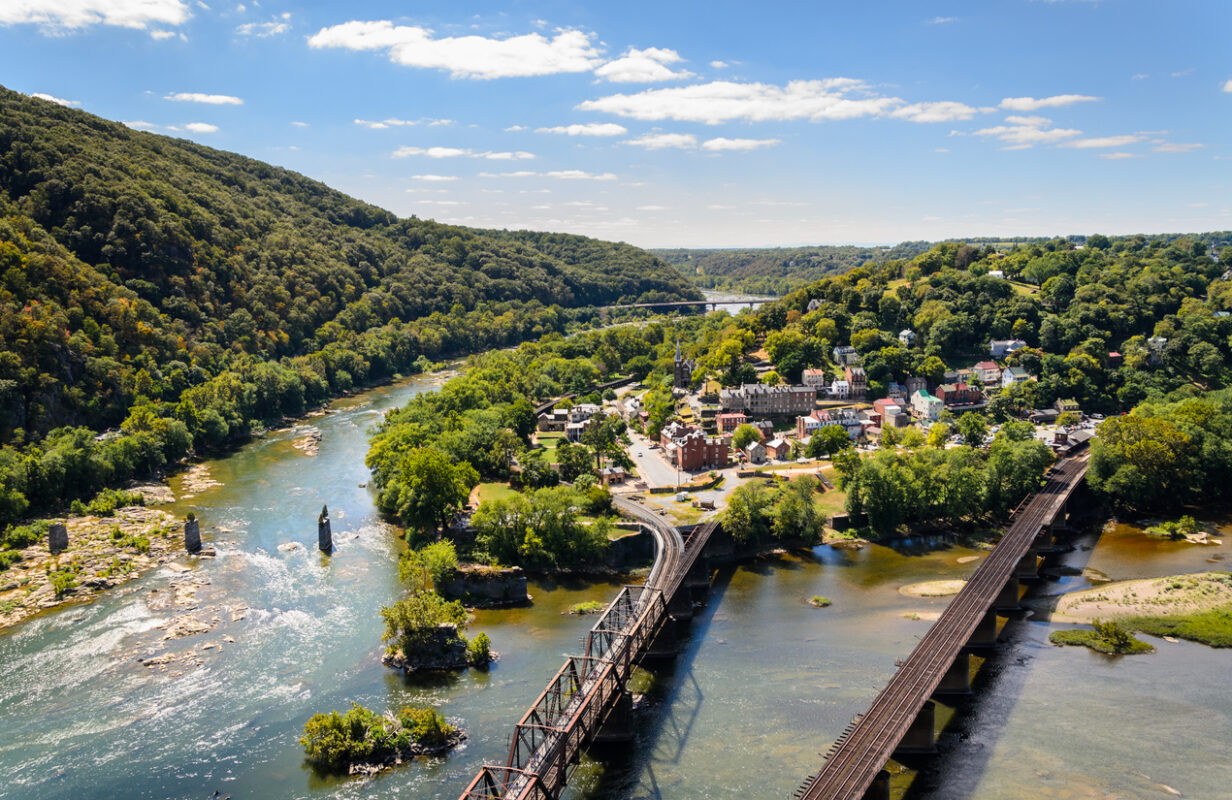
Longer days and flatter terrain during this month make hiking a bit easier, allowing many hikers to pick up the pace, with many covering 15-20 miles (24-32 km) a day. These states don’t have long stretches of the AT, so you’ll go through them in a matter of days to a week. The trail runs through populated areas, along roads, and through farmlands. Weather is still hot and water sources can be contaminated with farm pasture runoffs, so make sure you’re filtering your water.
New Jersey offers two great things: the feeling of remoteness in the wilderness and proximity to major cities. Elevation changes are generally moderate, and you’ll go through a whole spectrum of great views. AT also passes through the Wallkill National Wildlife Reserve, where you might encounter the state bird—the eastern goldfinch.
Distance: 72.4 miles (116.5 km)
New York has plenty to look forward to, but with its steep climbs and tough scrambles, it’s no walk in the park. Pass a Trailside Museum and Zoo in Bear Mountains (which is also the lowest elevation point on the entire AT), find numerous trailside delis, and you might even get a chance to see the Manhattan skyline from a distance.
Distance: 93 miles (149.7 km)
Connecticut, which is among the shortest sections of the AT, still features tough, rocky climbs—after which you’re rewarded with long miles of easy hiking and relaxing river walks. For most of the state, you’ll be hiking through the green tunnel, but every now and then, you’ll make your way out of the trees to witness spectacular panoramas.
Distance: 52 miles (83.7 km)
Massachusetts boasts longer views and higher elevations—on a clear day, you can see up to 90 miles (145 km) in the distance. From river walks and fields of conifer woodlands to charming New England towns, this state has it all. Massachusetts is also home to Mt. Greylock, the mountain which served as an inspiration for Melville’s Moby Dick.
Distance: 90.2 miles (145.2 km)
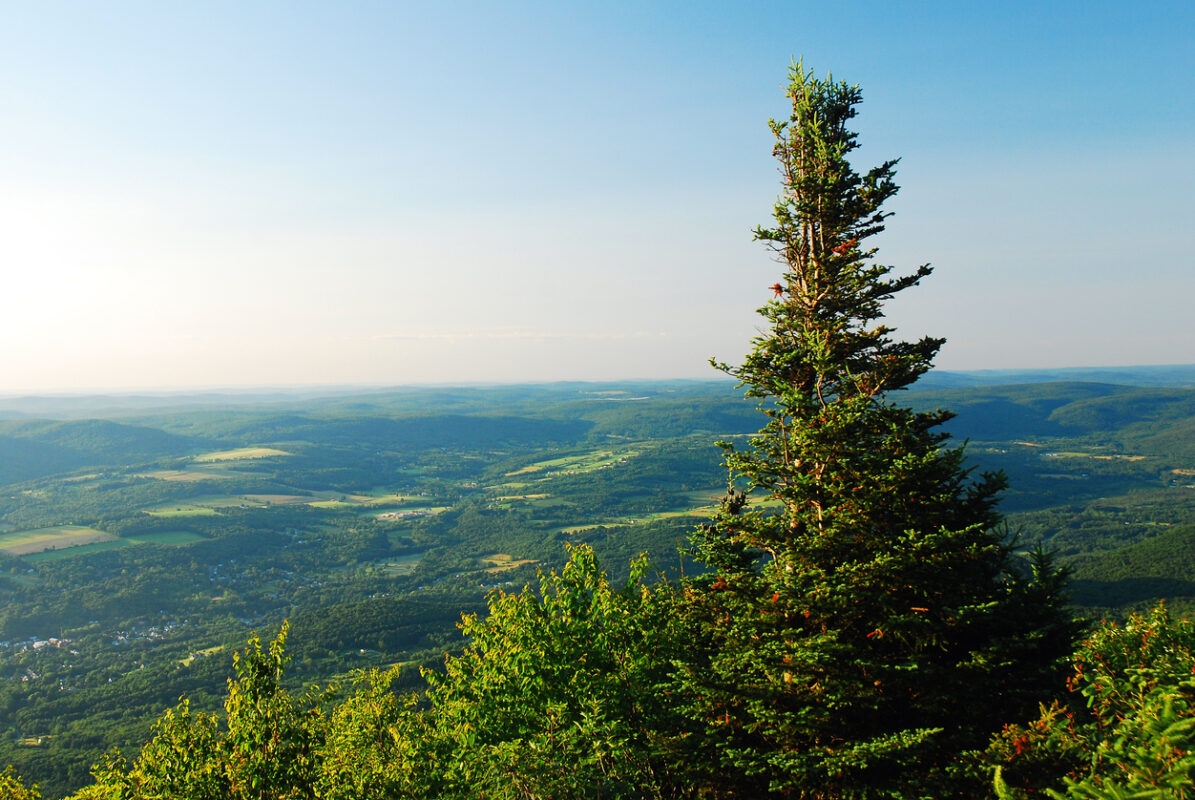
By now, you’ll have already built up your strength and stamina—and now’s the time when you’ll need it the most. The remaining 3 states are the hardest part of the entire Appalachian Trail with steep and rocky climbs up to 5,000-6,000 ft (1,524-1,829 m) high. Daily logistics and planning are also a must here, due to no campsites at the Appalachian balds. Hikers should finish up their hike by October 15 at the latest, when Baxter State Park—the end point of the thru-hike—closes the mountain down for hikers.
Vermont comes to the rescue if you’re sick of rocky terrain—there’s a reason why it’s called The Green Mountain State! Don’t let its dense forests and rolling pastures fool you, the trail is still challenging with vertical ascents up to 4,000 ft (1,219 m). Savor the verdant Vermont while you can, as the next state’s terrain is not as forgiving.
Distance: 150.8 miles (242.7 km)
New Hampshire’s portion of the AT offers more miles above the treeline than any other state. It’s nearly all within the White Mountain National Forest, and you can expect incredibly steep terrain. Mind your step, especially if there’s bad weather, and be prepared for a very tiring part of the AT. Still, New Hampshire will remain an unforgettable section with epic views that make the struggle worth it.
Distance: 160.9 miles (258.9 km)
Maine—the last part of the thru-hike. You made it! Maine is AT’s most challenging, rugged, and wild state, featuring wildlife and landscapes that are rare to see anywhere else on the trail, such as moose and sparkling lakes. You’ll encounter lots of slippery slopes, alpine bogs, and unbridged crossings. This is where you’ll pass the toughest mile, Mahoosuc Notch field filled with massive boulders, before you reach the infamous, final 100 miles of wilderness—a middle-of-nowhere section taking you to Baxter State Park and the final, most difficult ascent on Mt. Katahdin! The northern terminus is a place where thru-hikers take in and appreciate what they’ve just achieved.
Distance: 282 miles (453.8 km)

Congratulations on completing the iconic Appalachian Trail! Once you’re ready to leave the epic Mt. Katahdin, and finally go back to civilization for more than a day, your guides will pick you up from Baxter State Park and transfer you to Millinocket in Maine, a 45-minute drive. Meet your group of thru-hikers and have a celebratory dinner. After spending the night in Millinocket, your guides can transfer you to the nearest bus station. If you need to reach an airport, your guides can arrange that at an additional cost.

Arguably North America’s most famous long-distance hike, the Appalachian Trail is a 2,190-mile trail spanning the breadth of Eastern U.S. Thousands of people yearly attempt to thru-hike it, but only 1 in 4 makes it to the end. Which is why you should consider slackpacking, a supported thru-hike that will considerably increase your chances of completing the trail. Your guides will drop you off at the trailhead every morning and come pick you up in the evening, taking you to the nearest lodging. No sleeping in tents in the worst weather, no heavy backpacks, no worrying about your resupplies. While some food is included, it’s still mostly the responsibility of the hiker.
The hike will start in late-April or early May. This is a rough estimate of what a 5-month thru-hike of the Appalachian Trail northbound will look like. Each hiker can hike at their own pace. Learn how to prepare for thru-hiking the Appalachian Trail and check out these 15 AT hiking tips for first-timers by a three-time AT thru hiker.
There might be a few times that hikers will have to overnight on the trail due to lodging being too far. In that case, your guides will set up the camp near the trailhead and provide all the following equipment: camp stove, cooking pot, fuel canister, tent, sleeping bag and pad, and waterproof compression sack for the sleeping bag.
To learn more about what you can expect regarding the logistics of slackpacking the Appalachian Trail, scroll down and check out the FAQ.
Prior to actually getting on the trail and starting your epic journey, you’ll have a 3-day orientation in Villa Rica, GA, to prepare. You’ll go over gear, clothing, food, and the itinerary with your guides and your fellow thru-hikers. Shuttle to Amicalola Falls State Park, where you will register for the thru-hike. Then you’ll get transferred to Springer Mountain, the southern terminus where your life-changing adventure begins.
Each evening, thru-hikers will be picked up and transported to the nearest lodging facility, campground, or campsite area—whichever makes the most sense logistically and timewise. Note that there will be a few times that hikers will have to overnight on the trail because of no access points and long mileage days between roads. In that case, your guides will provide and set up gears and tents.

You’ll spend your first month passing through Georgia and North Carolina.
Georgia is a fantastic place to get into the mindset of thru-hiking—the trail is wide and smooth and the terrain is relatively easy compared to the rest of the trail. You’ll begin your journey in Springer Mountain and soon you’ll get used to day hikes through the wilderness.
Distance: 78.1 miles (125.7 km)
North Carolina starts to give you an idea of (literal) ups and downs of the AT. Just south of the Smokies, you can expect long climbs and many scenic views. The NC portion of the trail continues along the border with Tennessee.
Distance: 96.4 miles (155.1 km)
Keep in mind that the weather will be very cold with possible snow and ice at times. Average day temperatures could be anywhere between 20 and 50° F, while at night it could go down to 0° F.

Hike through your first trail town on the AT! These communities recognized as valuable places for thru-hikers, providing food, supplies, history, recreation, and much more. Once you’ve passed through the Smokies, the weather usually starts to warm up, and it could be time for a gear change.
Border of North Carolina & Tennessee runs along Great Smoky Mountains National Park (for which $25 permits are required), the most biologically diverse and the most visited NP in the States. Spectacular vistas are guaranteed, as you’ll frequently climb above 5,000 and 6,000 ft (1,524-1,829 m) and also pass through the highest point of the AT, the 6,625-foot (2,019-m) Clingmans Dome. You’ll reach your first trail town, Hot Springs.
Distance: 217.8 miles (350.5 km)
Tennessee welcomes you with the 2nd trail town of the AT, Erwin. Other than that, highlights of the state might be high-elevation summits, dense forests, and Laurel Fork, a serene gorge featuring 40-foot waterfalls. Hopefully, you’ll hit your 3rd trail city, Damascus, Virginia, just in time for a hiker festival, where you can expect a parade, arts & crafts booths, gear booths, prize giveaways, food trucks, and more!
Distance: 74.7 miles (120.2 km)

Weather begins to warm up and hikers need to switch to summer gear. Average day temperatures are around 50 to 90° F during the day, while the night brings a bit cooler weather at around 40 to 60° F.
Virginia has more miles of the AT than any other state, accumulating nearly a quarter of the entire trail length, and it’s a place where you’ll spend at least a month. While Southern Virginia is a challenging section featuring long climbs along the Blue Ridge Parkway, Northern Virginia and Shenandoah National Park boast mellow sections on farmland and rolling hills. Exit the park around Front Royal, and you’ll soon enter West Virginia.
Distance: 541.7 miles (871.8 km) + 25.2 miles (40.6 km) along VA/WV border

In July, the weather starts getting hot and humid. Be prepared for day temperatures going above 85° F. The terrain starts to get easier and flatter, but the trail itself becomes rockier.
West Virginia’s section of the Appalachian trail is by far the shortest, but still very important for thru-hikers as they pass through Harpers Ferry. Apart from being a site of notable Civil War battles, it’s also home to Appalachian Trail Conservancy’s headquarters and a symbolic AT midpoint.
Distance: 2.4 miles (3.9 km)
Maryland is a fan favorite—it hosts some of AT’s gentlest and flattest terrain, you can hike it in just 2 days, and it’s close to the buzzing Washington, D.C. Consider Maryland the calm before the storm, as you have the rocky Pennsylvania next up.
Distance: 40.9 miles (65.8 km)
Pennsylvania, also known as “Rocksylvania”, is where you get to show what you’re made of. While the north features rocky terrain that’ll test your feet, southern PA offers some of the smoothest terrain of the whole AT. Factor in historic landmarks and charming towns along the way as well as expansive views off the top of ridges, and you’ll find that you have to gird your loins for Pennsylvania’s rewards.
Distance: 229.8 miles (369.8 km)
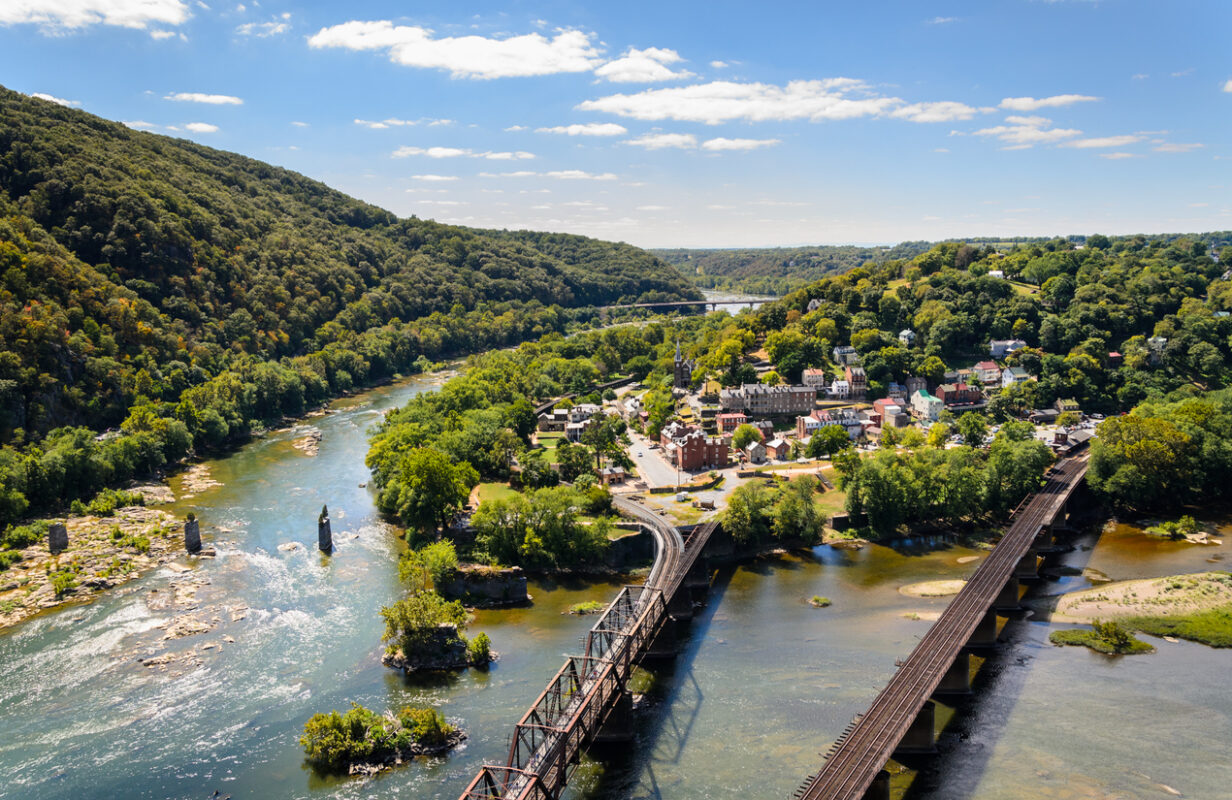
Longer days and flatter terrain during this month make hiking a bit easier, allowing many hikers to pick up the pace, with many covering 15-20 miles (24-32 km) a day. These states don’t have long stretches of the AT, so you’ll go through them in a matter of days to a week. The trail runs through populated areas, along roads, and through farmlands. Weather is still hot and water sources can be contaminated with farm pasture runoffs, so make sure you’re filtering your water.
New Jersey offers two great things: feeling of remoteness in the wilderness, but still being very close to major cities. Elevation changes are generally moderate, and you’ll go through a whole spectrum of great views. AT also passes through the Wallkill National Wildlife Reserve, where it’s likely you’ll meet the state bird—the eastern goldfinch.
Distance: 72.4 miles (116.5 km)
New York has plenty to look forward to, but with its steep climbs and tough scrambles, it’s no walk in the park. Pass a Trailside Museum and Zoo in Bear Mountains (which is also the lowest elevation point on the entire AT), find numerous trailside delis in this state, and there’s even a chance to see the Manhattan skyline from a distance.
Distance: 93 miles (149.7 km)
Connecticut, which is among the shortest sections of the AT, still features tough, rocky climbs—after which you’re rewarded with long miles of easy hiking and relaxing river walks. For most of the state, you’ll be hiking through the green tunnel, but every now and then, you’ll make your way out of the trees to witness spectacular panoramas.
Distance: 52 miles (83.7 km)
Massachusetts boasts longer views and higher elevations—on a clear day, you can see up to 90 miles (145 km) in the distance. From river walks and fields of conifer woodlands to charming New England towns, this state has it all. Massachusetts is also home to Mt. Greylock, the mountain which served as an inspiration to Melville to write Moby Dick.
Distance: 90.2 miles (145.2 km)
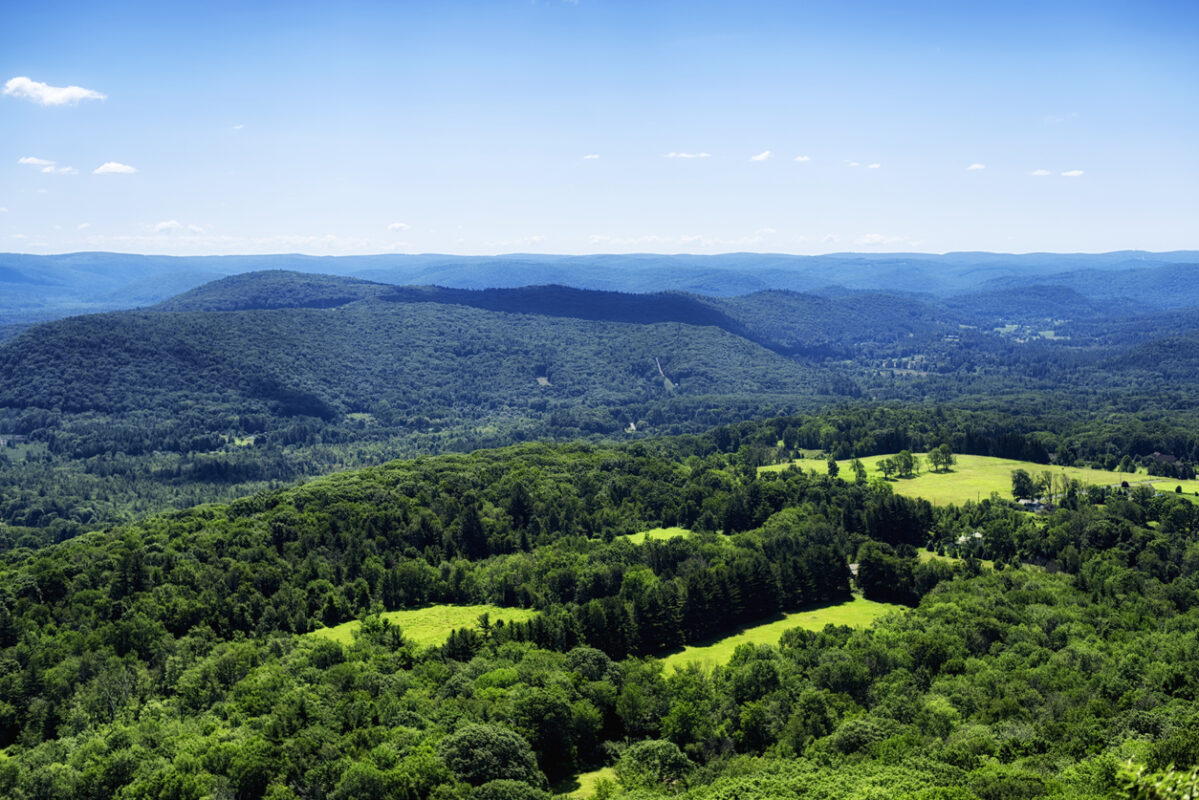
By now, you’ll have already built up your strength and stamina—and now’s the time when you’ll need it the most. The remaining 3 states are the hardest part of the entire Appalachian Trail with steep and rocky climbs up to 5,000-6,000 ft (1,524-1,829 m) high. Daily logistics and planning are also a must here, due to no campsites at the Appalachian balds. Some hikers will be finishing up their hike in October, but they have to be finished by October 15 when Baxter State Park—the end point—closes the mountain down to thru-hikers.
Vermont comes to the rescue if you’re sick of rocky terrain—there’s a reason why it’s called The Green Mountain State! Don’t let its dense forests and rolling pastures fool you, the trail is still challenging with vertical ascents up to 4,000 ft (1,219 m). Savor the verdant Vermont while you can, as the next state’s terrain is not as forgiving.
Distance: 150.8 miles (242.7 km)
New Hampshire’s portion of the AT offers more miles above treeline than any other state. It’s nearly all within the White Mountain National Forest, and you can expect incredibly steep terrain. Mind your step here, especially if there’s bad weather, and be prepared for a very tiring part of the AT. Still, New Hampshire will remain an unforgettable section with epic views that make the struggle worth it.
Distance: 160.9 miles (258.9 km)
Maine—the last part of the thru-hike. You made it! Maine is AT’s most challenging, rugged, and wild state, featuring wildlife and landscapes that are rare to see anywhere else on the trail, such as moose and sparkling lakes. You’ll encounter lots of slippery slopes, alpine bogs, and unbridged crossings. This is where you’ll pass the toughest mile, Mahoosuc Notch field filled with massive boulders, before you reach the infamous, final 100 miles of wilderness—a middle-of-nowhere section taking you to Baxter State Park and the final, most difficult ascent on Mt. Katahdin! The northern terminus is a place where thru-hikers take in and appreciate what they’ve just achieved.
Distance: 282 miles (453.8 km)
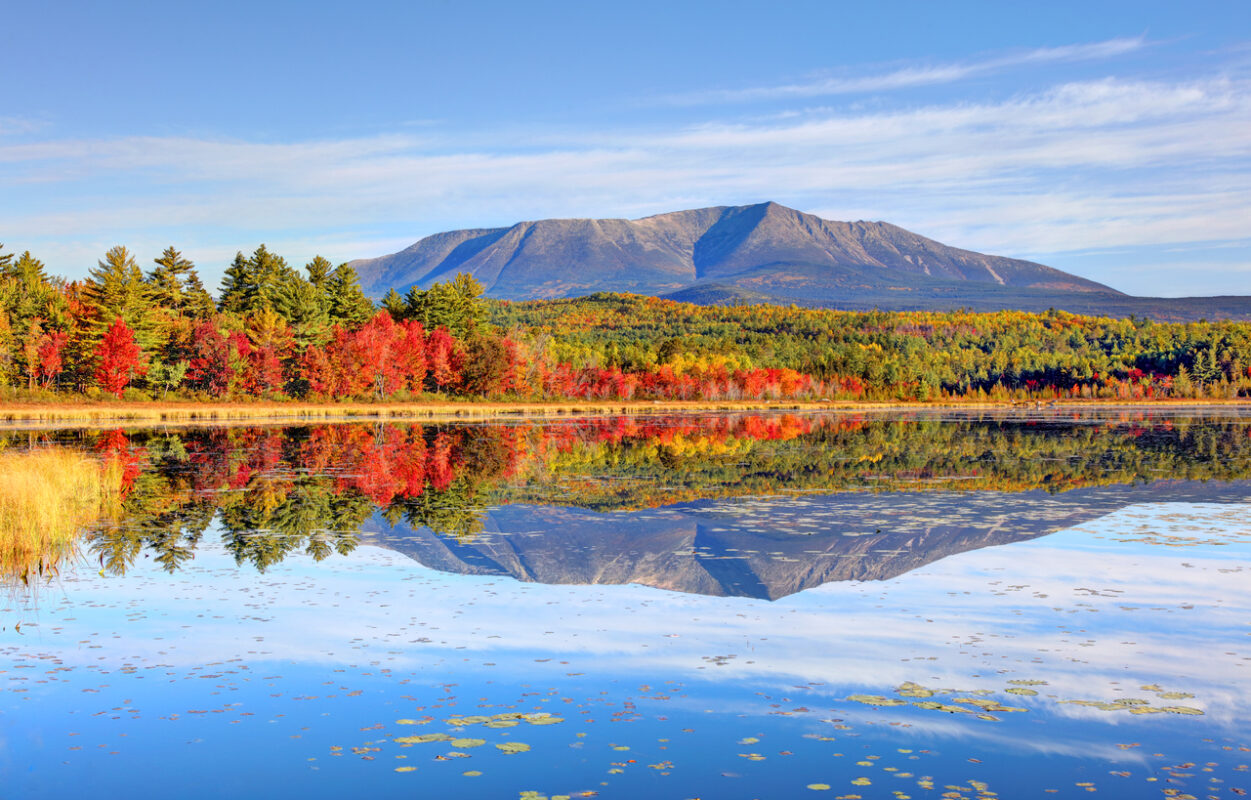
Congratulations on completing the iconic Appalachian Trail! Once you’re ready to leave the epic Mt. Katahdin, and finally go back to civilization for more than a day, your guides will pick you up from Baxter State Park and transfer you to Millinocket in Maine, a 45-minute drive. Meet your group of thru-hikers and have a celebratory dinner. After spending the night in Millinocket, your guides can transfer you to the nearest bus station. If you need to reach an airport, your guides can arrange that at an additional cost.
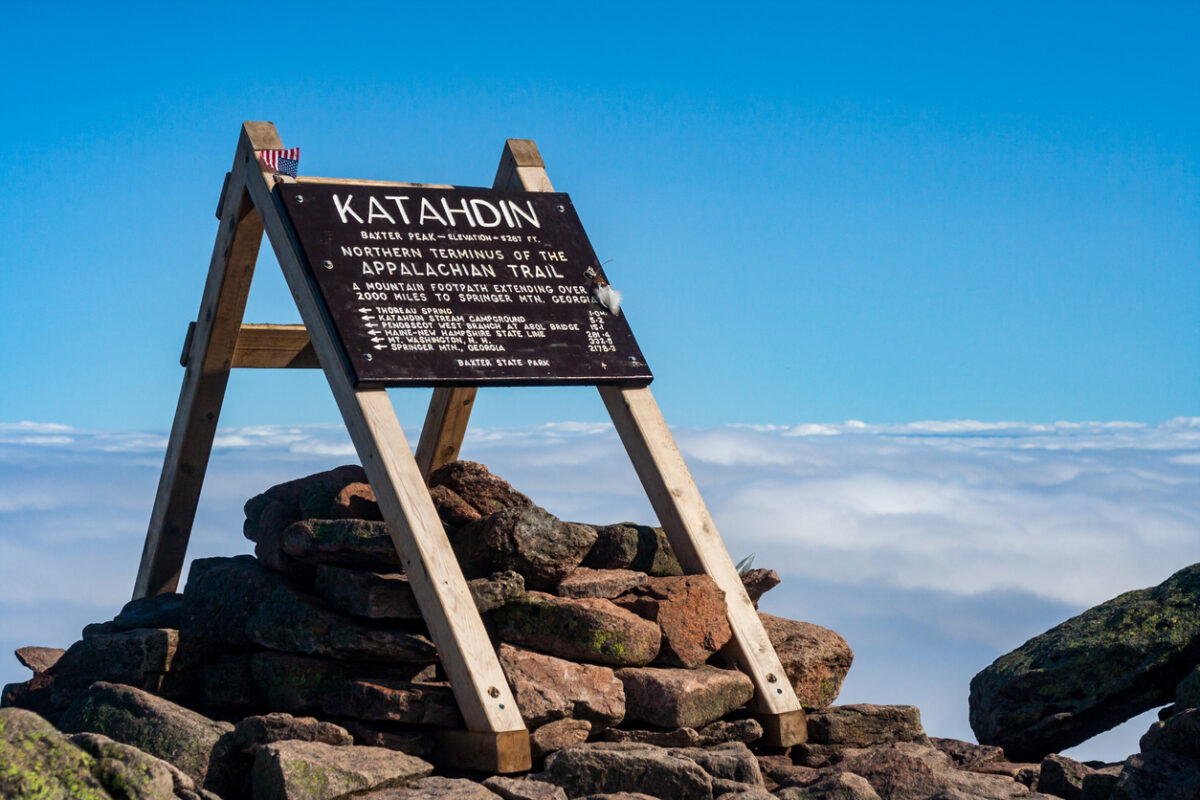
Thru-hiking the Appalachian Trail is on top of every serious hiker’s list. Not a lot of them dare to undertake it and even fewer people thru-hike it all—less than a 1,000 people manage to finish the AT yearly, and in 2024, you’re bound to be one of them. With our all-inclusive slackpack-supported thru-hike, the only thing you have to worry about is putting one foot in front of the other—from Georgia to Maine—and enjoy the journey at your own pace. You’ll be carrying a very light backpack with essentials for the day, allowing you to cover more distance. When evening comes, your guides will pick you up and transport you to the nearest lodging, and in the morning, they’ll take you back to the trail. Food of your own choice is also included in this supported thru-hike! Minimize all the risks hikers usually struggle on the AT with and maximize your fun and chances of success!
The hike will start in late-April or early May. This is a rough estimate of what a 5-month thru-hike of the Appalachian Trail northbound will look like. Each hiker can hike at their own pace. Learn how to prepare for thru-hiking the Appalachian Trail and check out these 15 AT hiking tips for first-timers by a three-time AT thru hiker.
There might be a few times that hikers will have to overnight on the trail due to lodging being too far. In that case, your guides will set up the camp near the trailhead and provide all the following equipment: camp stove, cooking pot, fuel canister, tent, sleeping bag and pad, and waterproof compression sack for the sleeping bag.
To learn more about what you can expect regarding the logistics of slackpacking the Appalachian Trail, scroll down and check out the FAQ.
.
Prior to actually getting on the trail and starting your epic journey, you’ll have a 3-day orientation in Villa Rica, GA, to prepare. You’ll go over gear, clothing, food, and the itinerary with your guides and your fellow thru-hikers. Shuttle to Amicalola Falls State Park, where you will register for the thru-hike. Then you’ll get transferred to Springer Mountain, the southern terminus where your life-changing adventure begins.
Each evening, thru-hikers will be picked up and transported to the nearest lodging facility, campground, or campsite area—whichever makes the most sense logistically and timewise. Note that there will be a few times that hikers will have to overnight on the trail because of no access points and long mileage days between roads. In that case, your guides will provide and set up tents and other needed gear.

You’ll spend your first month passing through Georgia and North Carolina.
Georgia is a fantastic place to get into the mindset of thru-hiking—the trail is wide and smooth and the terrain is relatively easy compared to the rest of the trail. You’ll begin your journey in Springer Mountain and soon you’ll get used to day hikes through the wilderness.
Distance: 78.1 miles (125.7 km)
North Carolina starts to give you an idea of (literal) ups and downs of the AT. Just south of the Smokies, you can expect long climbs and many scenic views. The NC portion of the trail continues along the border with Tennessee.
Distance: 96.4 miles (155.1 km)
Keep in mind that the weather will be very cold with possible snow and ice at times. Average day temperatures could be anywhere between 20 and 50° F, while at night it could go down to 0° F.
Hike through your first trail town on the AT! These communities recognized as valuable places for thru-hikers, providing food, supplies, history, recreation, and much more. Once you’ve passed through the Smokies, the weather usually starts to warm up, and it could be time for a gear change.
Border of North Carolina & Tennessee runs along Great Smoky Mountains National Park (for which $25 permits are required), the most biologically diverse and the most visited NP in the States. Spectacular vistas are guaranteed, as you’ll frequently climb above 5,000 and 6,000 ft (1,524-1,829 m) and also pass through the highest point of the AT, the 6,625-foot (2,019-m) Clingmans Dome. You’ll reach your first trail town, Hot Springs.
Distance: 217.8 miles (350.5 km)
Tennessee welcomes you with the 2nd trail town of the AT, Erwin. Other than that, highlights of the state might be high-elevation summits, dense forests, and Laurel Fork, a serene gorge featuring 40-foot waterfalls. Hopefully, you’ll hit your 3rd trail city, Damascus, Virginia, just in time for a hiker festival, where you can expect a parade, arts & crafts booths, gear booths, prize giveaways, food trucks, and more!
Distance: 74.7 miles (120.2 km)

Weather begins to warm up and hikers need to switch to summer gear. Average day temperatures are around 50 to 90° F during the day, while the night brings a bit cooler weather at around 40 to 60° F.
Virginia has more miles of the AT than any other state, accumulating nearly a quarter of the entire trail length, and it’s a place where you’ll spend at least a month. While Southern Virginia is a challenging section featuring long climbs along the Blue Ridge Parkway, Northern Virginia and Shenandoah National Park boast mellow sections on farmland and rolling hills. Exit the park around Front Royal, and you’ll soon enter West Virginia.
Distance: 541.7 miles (871.8 km) + 25.2 miles (40.6 km) along VA/WV border
In July, the weather starts getting hot and humid. Be prepared for day temperatures going above 85° F. The terrain starts to get easier and flatter, but the trail itself becomes rockier.
West Virginia’s section of the Appalachian trail is by far the shortest, but still very important for thru-hikers as they pass through Harpers Ferry. Apart from being a site of notable Civil War battles, it’s also home to Appalachian Trail Conservancy’s headquarters and a symbolic AT midpoint.
Distance: 2.4 miles (3.9 km)
Maryland is a fan favorite—it hosts some of AT’s gentlest and flattest terrain, you can hike it in just 2 days, and it’s close to the buzzing Washington, D.C. Consider Maryland the calm before the storm, as you have the rocky Pennsylvania next up.
Distance: 40.9 miles (65.8 km)
Pennsylvania, also known as “Rocksylvania”, is where you get to show what you’re made of. While the north features rocky terrain that’ll test your feet, southern PA offers some of the smoothest terrain of the whole AT. Factor in historic landmarks and charming towns along the way as well as expansive views off the top of ridges, and you’ll find that you have to gird your loins for Pennsylvania’s rewards.
Distance: 229.8 miles (369.8 km)

Longer days and flatter terrain during this month make hiking a bit easier, allowing many hikers to pick up the pace, with many covering 15-20 miles (24-32 km) a day. These states don’t have long stretches of the AT, so you’ll go through them in a matter of days to a week. The trail runs through populated areas, along roads, and through farmlands. Weather is still hot and water sources can be contaminated with farm pasture runoffs, so make sure you’re filtering your water.
New Jersey offers two great things: feeling of remoteness in the wilderness, but still being very close to major cities. Elevation changes are generally moderate, and you’ll go through a whole spectrum of great views. AT also passes through the Wallkill National Wildlife Reserve, where it’s likely you’ll meet the state bird—the eastern goldfinch.
Distance: 72.4 miles (116.5 km)
New York has plenty to look forward to, but with its steep climbs and tough scrambles, it’s no walk in the park. Pass a Trailside Museum and Zoo in Bear Mountains (which is also the lowest elevation point on the entire AT), find numerous trailside delis in this state, and there’s even a chance to see the Manhattan skyline from a distance.
Distance: 93 miles (149.7 km)
Connecticut, which is among the shortest sections of the AT, still features tough, rocky climbs—after which you’re rewarded with long miles of easy hiking and relaxing river walks. For most of the state, you’ll be hiking through the green tunnel, but every now and then, you’ll make your way out of the trees to witness spectacular panoramas.
Distance: 52 miles (83.7 km)
Massachusetts boasts longer views and higher elevations—on a clear day, you can see up to 90 miles (145 km) in the distance. From river walks and fields of conifer woodlands to charming New England towns, this state has it all. Massachusetts is also home to Mt. Greylock, the mountain which served as an inspiration to Melville to write Moby Dick.
Distance: 90.2 miles (145.2 km)

By now, you’ll have already built up your strength and stamina—and now’s the time when you’ll need it the most. The remaining 3 states are the hardest part of the entire Appalachian Trail with steep and rocky climbs up to 5,000-6,000 ft (1,524-1,829 m) high. Daily logistics and planning are also a must here, due to no campsites at the Appalachian balds. Hikers should finish up their hike by October 15 at the latest, when Baxter State Park—the end point of the thru-hike—closes the mountain down for hikers.
Vermont comes to the rescue if you’re sick of rocky terrain—there’s a reason why it’s called The Green Mountain State! Don’t let its dense forests and rolling pastures fool you, the trail is still challenging with vertical ascents up to 4,000 ft (1,219 m). Savor the verdant Vermont while you can, as the next state’s terrain is not as forgiving.
Distance: 150.8 miles (242.7 km)
New Hampshire’s portion of the AT offers more miles above treeline than any other state. It’s nearly all within the White Mountain National Forest, and you can expect incredibly steep terrain. Mind your step here, especially if there’s bad weather, and be prepared for a very tiring part of the AT. Still, New Hampshire will remain an unforgettable section with epic views that make the struggle worth it.
Distance: 160.9 miles (258.9 km)
Maine—the last part of the thru-hike. You made it! Maine is AT’s most challenging, rugged, and wild state, featuring wildlife and landscapes that are rare to see anywhere else on the trail, such as moose and sparkling lakes. You’ll encounter lots of slippery slopes, alpine bogs, and unbridged crossings. This is where you’ll pass the toughest mile, Mahoosuc Notch field filled with massive boulders, before you reach the infamous, final 100 miles of wilderness—a middle-of-nowhere section taking you to Baxter State Park and the final, most difficult ascent on Mt. Katahdin! The northern terminus is a place where thru-hikers take in and appreciate what they’ve just achieved.
Distance: 282 miles (453.8 km)

Congratulations on completing the iconic Appalachian Trail! Once you’re ready to leave the epic Mt. Katahdin, and finally go back to civilization for more than a day, your guides will pick you up from Baxter State Park and transfer you to Millinocket in Maine, a 45-minute drive. Meet your group of thru-hikers and have a celebratory dinner. After spending the night in Millinocket, your guides can transfer you to the nearest bus station. If you need to reach an airport, your guides can arrange that at an additional cost.




What you get on this adventure:
What’s not included:
What you get on this adventure:
What’s not included:
After much research, you’ve made up your mind and decided to thru-hike the Appalachian Trail, but what now? There are many decisions and preparations ahead—logistics, gear, resupplies, just to name a few—but you don’t know where to get started? The whole trail measures 2,190 miles (3,524 km) in length, so carrying all your belongings, camping gear, and food every single day for 5 months is no walk in a park.
Imagine this: you’re carrying a light backpack, doing longer mile days, not stressing about the food and resupplies, all the while getting the classic thru-hike experience of pitching a tent in the woods almost every night.
This is where we come in! Apart from an experienced hiker joining for the first month to ensure everyone’s comfortable hiking on their own, a support vehicle will follow you all the way through. You’ll hike at your own pace and meet your support vehicle every 1-3 days. Here you’ll have lots of space for your extra food, gear, clothing, and toiletries.
About once a week, you’ll be transferred to a near-by town for a hostel, hotel, or cabin stay, where you can resupply, shower, and do laundry. This way, you don’t have to hitchhike or pay for expensive shuttles into town.
This is a fantastic trip for solo travelers, as the support vehicle also serves as security—each hiker needs to check in every time they reach the vehicle or a crew member will hike back until they find them. Apart from the support vehicle serving as storage and security, you can also take showers, clean up, or take a break if you have a slight injury.
Check out our webinar on what it takes to thru-hike the Appalachian Trail with Michelle Michaud, a guide who completed thru-hiking the AT 3 times! Although everyone has a different experience, it’s a good idea to read what people have to say about their own time in the wilderness and what it’s like thru-hiking the Appalachian Trail.
The Appalachian Trail has been your life-long dream, but you’re just not the biggest fan of tents, backpacks and lack of amenities on trail?
Thru-hiking the AT is a life-changing experience, but it’s also a massive sacrifice of your time, your comfort, and of your habits. If you’re still very eager to thru-hike the AT without turning your whole life upside down, join your expert guide Michelle Michaud who completed thru-hiking the AT 3 times and let us deal with the logistics and planning your adventure. This way, you won’t have to worry about any of these:
First off, a support vehicle will drop you off at the trailhead every day with the days’ itinerary and pick you up at the end of the day, taking you to a lodging facility. The vehicle also allows some flexibility in case of injuries, sickness, or just taking a break.
Every night you’ll be taken to the nearest hotel, hostel, or cabin. Instead of pitching your tent every night, you’ve got your accommodation settled! This way, you get to clean up, do your laundry, resupply, and have a good night’s sleep in a comfy bed. By choosing the All-Inclusive Hike, you won’t have to worry about food either as all your meals will be sorted!
There will also be a guide by your side at the beginning of the trek, until all hikers are comfortable hiking on their own. Hike at your own pace. Skip a day and hang out if the weather is bad. Hike alone or with a group. Your guides are here to help you succeed on your journey however you wish to do it.
And the most important thing—you’ll only be carrying a very light backpack, filled with basics that you might need throughout the day. No extra weight of a tent, sleep gear, food, or clothes slowing you down. This allows you to cover 10-20 miles per day, ultimately making your hike significantly shorter than it would be with all the extra baggage.
This supported and slackpacking adventures will roughly take 5 months, during which time you’ll get stronger and fitter. However, you still need to be prepared for such a demanding thru-hike of the Appalachian Trail.
No experience is universal—among many other things, your age, health, and current fitness level determine how ready you are for the hike. Going on this supported AT thru-hike has lots of benefits that will put less strain on your body and shorten your time on the trail. Apart from carrying a significantly lighter backpack, you’ll also meet your support vehicle to resupply and have frequent access to amenities.
There’s no shortage of books, guides, and diaries about the AT, so it’s best to read through some of them and find out just how much preparation you will need—the internet is your friend here. You can check out what our guide Michelle has to say about preparing for the thru-hike of the Appalachian Trail. As you can see, there’s a lot of preparation involved—check out these 15 tips for a thru-hiking first timer!
If thru-hiking the AT seems too big of an undertaking for you, join in at a later date and hike a section of the trail or check out shorter guided trips along the Appalachian Trail.
The camaraderie, trail magic, and the sheer number of hikers all make the trail accessible for just about anyone. People of all ages, from 5 to 86 have hiked the trail.
The hiking community varies in age, occupation, experience and fitness levels. While there are hikers in their 20s and 30s, there are even more hikers in their 50s or even 60s. The only criteria you have to fit is to have a desire to be outdoors!
Everybody over the age of 16 is welcome on this hiking adventure.
This is a fantastic trip for solo travelers!
The support vehicle serves as security—each hiker needs to check in every time they reach the vehicle or a crew member will hike back until they find them.
You will also meet many hikers who share the same values and goals and make friends for life!
There are many gear lists for thru-hiking the AT available online. Your guides who thru-hiked the AT more than once put together a list of items they deem necessary. However, there may be some items here that you consider unnecessary or some that didn’t make the list, but you’d still like to take them. Feel free to contact us should you have any questions or dilemmas regarding the equipment, we’re happy to help!
Here’s a list of obligatory equipment you need to bring:
This is a list of clothing we recommend you bring:
Here’s a list of personal gear you should bring:
These are the toiletries and first aid supplies we recommend bringing:
Your guides who thru-hiked the AT more than once put together a list of items they deem necessary. However, there may be some items here that you consider unnecessary or some that didn’t make the list, but you’d still like to take them. Feel free to contact us if you have any questions regarding the equipment—we’re happy to help!
Here’s a list of obligatory equipment you need to bring:
Here’s a list of personal gear you need to bring:
This is a list of clothing we recommend you bring:
These are the toiletries and first aid supplies we recommend bringing:
There will be a few times that hikers will have to overnight on the trail due to lodging being too far. In that case, your guides will set up the camp near the trailhead and provide all the following equipment: camp stove, cooking pot, fuel canister, tent, sleeping bag and pad, and waterproof compression sack for the sleeping bag.
The maximum group size for this supported AT thru-hike is 10. It takes a minimum of 5 people for this tour to operate.
Since this is a big 5-month undertaking, your guide will collect entries for the trip for up to 20 people. First 10 people that confirm their booking by paying the first month will join her on the trail, and the other 10 will join a waitlist in case anyone has to cancel their participation.
The cost does not decrease as the group grows.
It is expected that the trip will soon reach the minimum number of people to run in 2024.
The itinerary that reaches the minimum number of people first is set to go out. In that case, those who were initially interested in the other trip can join the one that’s running.
Upon registration you will have to pay a $200 deposit. Should the thru-hike not happen, you will get your full deposit back. The first month is to be paid until December 31, 2023, which is also the deadline for informing clients if the hike is going out.
You’re doing a northbound thru-hike of the AT, meaning that your adventure starts in Georgia. As you have a 3-day orientation prior to getting on the trail in Villa Rica, most people fly into Hartsfield-Jackson Atlanta International Airport (ATL). Your guides will pick you up at the airport and transfer you to Villa Rica.
AT ends in Baxter State Park, Maine. Your guides will pick you up and transfer to Millinocket or the nearest bus station. Shuttle to the nearest airport is also available, but at an additional fee.
57hours is committed to providing safe outdoor adventure experiences. We require all guides using our platform to have a COVID-19 safety plan and to make the details of that plan accessible to travelers. In most cases, group sizes will be reduced, guides will avoid overcrowded locations, and other safety measures will be met depending on the location and activity.
We also expect clients to respect local regulations and take measures to protect themselves, their guides, and the communities they’re traveling to. For more information on COVID-19 measures in the U.S., please refer to international travel requirements in the U.S. If you’d like to check states through which the AT runs individually, please refer to travel requirements in Georgia, North Carolina, Tennessee, New York, Connecticut, Massachusetts, Vermont, New Hampshire, Maine, Virginia, West Virginia, Maryland, Pennsylvania, New Jersey.
Please contact us if you have any questions or require further information. We are happy to provide you with the most up-to-date information!
There are two thru-hikes offered for 2024: the Supported thru-hike of the Appalachian Trail and Slackpacking the AT, both beginning late-April or May. The first one to reach the minimum number of participants will be confirmed and carried out.
Should the thru-hike not happen, you will get your full deposit back.
Hiking for only a month or two is also possible for a different fee. Let us know which months you’d like to join and your guide will offer you a price based on your preferences. Feel free to contact us for more information!
